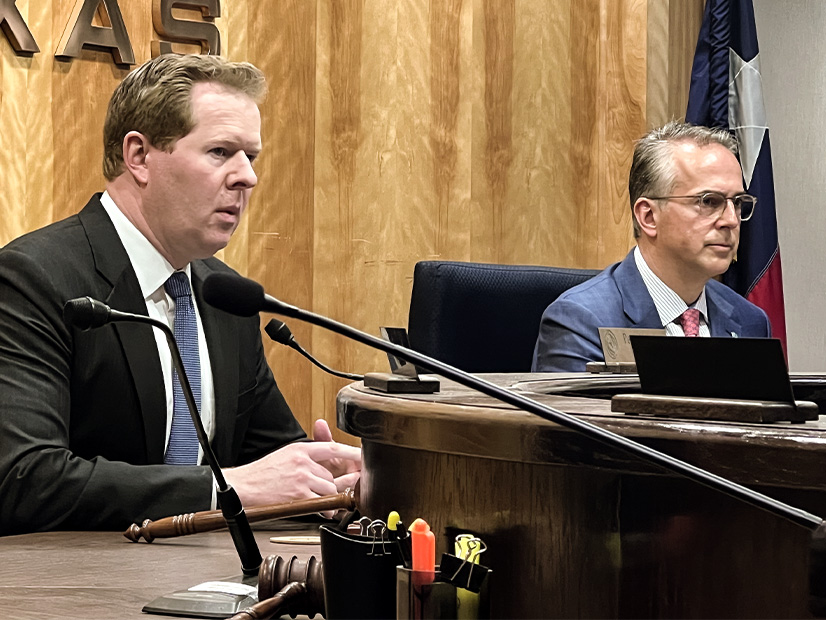
ERCOT’s final resource adequacy assessment for the summer indicates the grid operator will have “sufficient” installed capacity to meet expected record demand during the next few months.
However, Public Utility Commission of Texas Chair Peter Lake chose to highlight the lack of dispatchable — or thermal — generation to meet that demand. During a press conference Wednesday to provide what has become an annual public update before the summer, Lake used the modifier “on-demand dispatchable” 10 times when referring to power, generation or generators.
For the first time this summer, he said, ERCOT’s data shows demand will exceed “on-demand dispatchable power.”
“So, we will be relying on renewables to keep the lights on during the hottest days of summer,” Lake said.
Ironically, the Texas Legislature has moved bills during the current session that add costs and requirements for renewables. Lawmakers have instead focused on legislation designed to incent the construction of more thermal generation. (See Texas Legislature Moves Bills Remaking the ERCOT Market.)
Lake said that between 2008 and 2020, Texas’ population increased by 24% while the state’s “on-demand dispatchable power supply” grew by only 1.5%. He said demand continues to grow with the state adding the equivalent of the population of Oakland, Calif., (433,823 residents as of 2021, according to the U.S. Census Bureau and other sources) and their “devices” requiring electricity every year.
Oakland has replaced Corpus Christi, Texas, (population: 317,863), which Lake and ERCOT CEO Pablo Vegas used in the example last year.
“The increase in demand for electricity is outpacing the supply of on-demand dispatchable power in this new reality,” Lake said. “Our risk goes up as the sun goes down because it’s still hot at 9 p.m. Our solar generation is all gone, so at that point in the day we will be relying on wind generation on our hottest days. We may not have enough on-demand dispatchable generation to cover the gap between when the sun sets and we lose the solar, and when our wind generation picks up.”
According to ERCOT’s seasonal assessment of resource adequacy (SARA), which assumes typical summer grid conditions, the ISO has enough capacity to meet a summer peak of 82.7 GW. That would smash the current record of 80.04 GW, set last July.
The report says more than 97 GW of summer-rated resources are expected to be available for the summer peak. That includes 65.1 GW of thermal resources, a slight increase from last summer’s 63.5 GW number. The grid operator expects to have on hand another 10.4 GW of summer-rated wind resources and 12.3 GW of solar.
The SARA’s most severe risk scenario assumes a high peak load, extreme unplanned thermal plant outages, and extreme low wind power production. However, Vegas said that probability is less than 1%.
Noting that most of the new capacity added since last summer comes from renewables, Vegas said ERCOT could see more tighter hours than last summer and after the traditional 5 p.m. peak load hour. Scarcity conditions are more likely around 9 p.m., after the sun sets and before wind picks up.
Lake said there were at least 12 days last summer when ERCOT experienced tight conditions between 8 p.m. and 10 p.m. He said less than 20% of all wind turbines were generating, despite data showing “on our hottest days we need 50% of all the windmills generating power at 9 p.m.”
“To help mitigate these risks, we’re going to continue to operate the grid conservatively as we have been doing,” Vegas said. “That means bringing generating resources online earlier to mitigate any sudden changes in generation or demand. We plan to operate a reliable and resilient grid this summer.”
Help for Ramping
The grid operator also will launch a new ancillary service on June 8, ERCOT contingency reserve service, that will address the rapid ramps that can occur when renewable resources are operating.
“The urgency to move forward with meaningful electric market reforms that will incentivize the development of dispatchable generation remains extremely high,” Vegas said. “I’ve described many of the tools that we have to deal with the real-time operational challenges that we have, but these do not substitute for significant market reforms that will incentivize the development of new dispatchable generation and to help preserve older generation until it can be replaced.”
ERCOT also released its semi-annual capacity, demand and reserves report (CDR) for the next 10 years. The report provides forecasted planning reserve margins (PRMs) for the summer and winter peak load seasons, forecasting a 2024 summer PRM of 33.9%. That’s a six-percentage point drop from the November CDR.
The grid operator defines the PRM as the percentage of resource capacity greater than firm demand and available to cover uncertainty in future demand, generator availability and new resource supply. Firm demand accounts for load reductions available through interruptible load programs and incremental load reductions from rooftop solar systems that are not accounted for in the load-forecast models.
According to the report, demand will exceed 85 GW next summer and peak at 71.5 GW during the 2024-25 winter.



